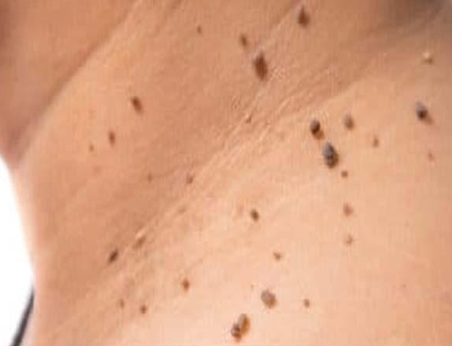Skin warts are caused by a virus called the human papillomavirus (HPV). HPV is a contagious virus that can be spread through direct contact with a person who has warts or through contact with surfaces or objects that have been in contact with the virus. There are more than 100 types of HPV, and some of them can cause warts on different parts of the body, including the hands, feet, and genital area.
HPV can enter the body through a cut or break in the skin, and once inside, it can cause the skin cells to grow abnormally, leading to the formation of warts. Some people are more susceptible to HPV infections than others, and certain factors, such as a weakened immune system, can increase the risk of developing warts. Additionally, warts are more common in children and young adults, as their immune systems are still developing and may not be able to fight off the virus as effectively.

Risk Factors Associated with Skin Warts:
Given below are some of the common risk factors associated with skin warts include:
- Weakened Immune System: People with weakened immune systems, such as those with HIV/AIDS, cancer, or taking immunosuppressant drugs, are at a higher risk of developing warts.
- Age: Warts are more common in children and teenagers due to their underdeveloped immune systems.
- Genetics: Certain individuals may have a genetic predisposition to developing warts.
- Damaged Skin: Warts are more likely to develop on skin that has been damaged or injured, such as cuts, scrapes, or burns.
- Swimming Pools and Showers: Public swimming pools and showers can be breeding grounds for the HPV virus, increasing the risk of developing warts.
- Occupation: People who work with meat, poultry, or fish may be at a higher risk of developing warts due to exposure to the HPV virus found in these animals.
- Personal Habits: Biting your nails or picking at your skin can increase the risk of developing warts, as it can introduce the HPV virus into broken skin.
It is important to practice good hygiene, such as washing your hands regularly and avoiding touching warts, to reduce the risk of developing skin warts. If you do develop a wart, it is important to seek treatment to prevent it from spreading to other areas of your skin or to other people.
Warts Removal Techniques:
They can be unsightly and may cause discomfort or embarrassment. Here are some ways to remove warts:
- Over-the-counter treatments: You can purchase over-the-counter treatments like salicylic acid, which can be found in gels, pads, and liquids. These treatments work by removing the dead skin cells on the surface of the wart.
- Cryotherapy: Cryotherapy involves freezing the wart with liquid nitrogen. The freezing causes the wart to blister and fall off.
- Surgical removal: A doctor can surgically remove the wart by cutting it out or using an electric needle.
- Laser treatment: Laser treatment involves using a laser to destroy the blood vessels feeding the wart, causing it to die and fall off.
- Duct tape: Covering the wart with duct tape for several days can sometimes cause it to disappear.
It’s important to note that while these methods can be effective, warts can sometimes return after treatment. It’s also possible to spread warts to other parts of your body or to other people, so it’s important to take precautions to prevent spreading the virus. Consult a healthcare professional before attempting any of these treatments.